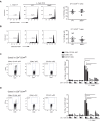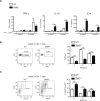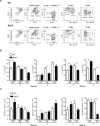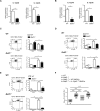Batf3-dependent CD103+ dendritic cells are major producers of IL-12 that drive local Th1 immunity against Leishmania major infection in mice
- PMID: 25312824
- PMCID: PMC4316187
- DOI: 10.1002/eji.201444651
Batf3-dependent CD103+ dendritic cells are major producers of IL-12 that drive local Th1 immunity against Leishmania major infection in mice
Abstract
The role of different DC subsets in priming and maintenance of immunity against Leishmania major (L. major) infection is debated. The transcription factor basic leucine zipper transcription factor, ATF-like 3 (Batf3) is essential for the development of mouse CD103(+) DCs and some functions of CD8α(+) DCs. We found that CD103(+) DCs were significantly reduced in the dermis of Batf3-deficient C57BL/6 mice. Batf3(-/-) mice developed exacerbated and unresolved cutaneous pathology following a low dose of intradermal L. major infection in the ear pinnae. Parasite load was increased 1000-fold locally and expanded systemically. Batf3 deficiency did not affect L. major antigen presentation to T cells, which was directly exerted by CD8α(-) conventional DCs (cDCs) in the skin draining LN. However, CD4(+) T-cell differentiation in the LN and skin was skewed to nonprotective Treg- and Th2-cell subtypes. CD103(+) DCs are major IL-12 producers during L. major infection. Local Th1 immunity was severely hindered, correlating with impaired IL-12 production and reduction in CD103(+) DC numbers. Adoptive transfer of WT but not IL-12p40(-/-) Batf3-dependent DCs significantly improved anti-L. major response in infected Batf3(-/-) mice. Our results suggest that IL-12 production by Batf3-dependent CD103(+) DCs is crucial for maintenance of local Th1 immunity against L. major infection.
Keywords: Adaptive immune response ⋅ Batf3 ⋅ Dendritic cells ⋅ IL-12 ⋅ Leishmania major.
© 2014 The Authors. European Journal of Immunology published by WILEY-VCH Verlag GmbH & Co. KGaA, Weinheim.
Figures





References
-
- Belkaid Y, Mendez S, Lira R, Kadambi N, Milon G, Sacks D. A natural model of Leishmania major infection reveals a prolonged “silent” phase of parasite amplification in the skin before the onset of lesion formation and immunity. J. Immunol. 2000;165:969–977. - PubMed
-
- Kapsenberg ML. Dendritic-cell control of pathogen-driven T-cell polarization. Nat. Rev. Immunol. 2003;3:984–993. - PubMed
-
- Ritter U, Osterloh A. A new view on cutaneous dendritic cell subsets in experimental leishmaniasis. Med. Microbiol. Immunol. 2007;196:51–59. - PubMed
-
- Kautz-Neu K, Schwonberg K, Fischer MR, Schermann AI, von Stebut E. Dendritic cells in Leishmania major infections: mechanisms of parasite uptake, cell activation and evidence for physiological relevance. Med. Microbiol. Immunol. 2012;201:581–592. - PubMed
-
- León B, López-Bravo M, Ardavín C. Monocyte-derived dendritic cells formed at the infection site control the induction of protective T helper 1 responses against Leishmania. Immunity. 2007;26:519–531. - PubMed
Publication types
MeSH terms
Substances
Grants and funding
LinkOut - more resources
Full Text Sources
Other Literature Sources
Medical
Molecular Biology Databases
Research Materials

